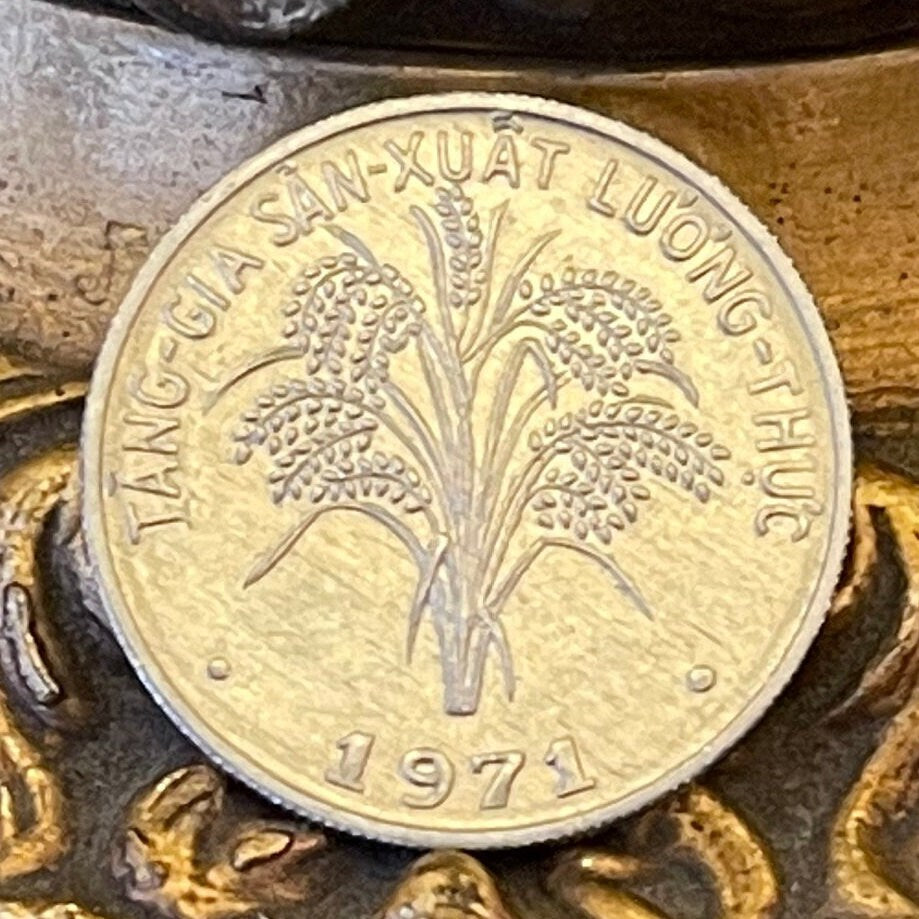elemintalshop
Rice Stalks 1 Dong Vietnam Authentic Coin Money for Jewelry and Craft Making (South Vietnam) (1971)
Rice Stalks 1 Dong Vietnam Authentic Coin Money for Jewelry and Craft Making (South Vietnam) (1971)
Couldn't load pickup availability
Rice Stalks 1 Dong Vietnam Authentic Coin Money for Jewelry and Craft Making (South Vietnam) (1971)
Commemorative issue: FAO
Reverse: Rice stalks, FAO legend above, date at the bottom.
Lettering: TĂNG-GIA SẢN-XUẤT LU’O’NG-THỤ’C
• 1971 •
Translation: Increase in the food production of farms in grains
• 1971 •
Obverse: Denomination and name of country.
Lettering: VIỆT-NAM CỌNG-HOÀ
1 ĐỒNG
Translation: Republic of Vietnam
1 Dong
Edge: Reeded
Features
Issuer South Vietnam
Period Second Republic (1967-1975)
Type Circulating commemorative coin
Year 1971
Value 1 Đồng (1)
Currency Southern đồng (1953-1975)
Composition Aluminium
Weight 1.2000 g
Diameter 22.5 mm
Thickness 1.36 mm
Shape Round
Technique Milled
Orientation Medal alignment ↑↑
Demonetized Yes
Number N# 6821
References KM# 12, Schön# 46
Wikipedia:
Rice production in Vietnam in the Mekong and Red River deltas is important to the food supply in the country and national economy. Vietnam is one of the world's richest agricultural regions and is the second-largest (after Thailand) exporter worldwide and the world's seventh-largest consumer of rice. The Mekong Delta is the heart of the rice-producing region of the country where water, boats, houses and markets coexist to produce a generous harvest of rice.
Rice is called ‘white gold’ in Vietnam and has a link to the Sanskrit name ‘Dhanya’ (meaning: "the sustainer of the human race"), the name given to Rice in India. In Vietnam, there is a folklore that is narrated on rice. According to the folk legend, in ancient times, rice was not produced but was summoned by fervent prayers by people. Rice would appear from the heaven in the form of a large ball in every house. On one occasion, a lady was sweeping the floor of her house as ordered by her husband to welcome the rice ball. The large rice ball landed in the house when the lady was still sweeping and it hit the broom and then broke into many pieces. Since then people of Vietnam had to work hard with their hands to grow rice.
Rice cultivation probably happened as a creation event between fifteen and eight thousand years ago. During this window rice has been prosperously grown in Vietnam, China, Madagascar, India, East Africa, South Carolina and many other locales. Unknown merchants and sailors likely made this into the rice commodity as it is known today.
Rice growing in Mekong Delta has an ancient history traced to the Khmer regime of the 18th century. It was taken over by the Vietnamese. However, the Cambodians still consider this area as "KamPuchea Krom or Lower Cambodia" not able to forget that they owned this area in the past. Cambodia even attacked Vietnam in 1978 to take control of the Mekong Delta. However, they were decisively defeated. This delta was the last part of the present day Vietnam that was annexed from Cambodia.
Its present status under the Vietnamese is, however, as a very large swathe of green carpet of rice paddy. This development is attributed to the French who colonized Vietnam in the middle of the 19th century with the basic objective of exporting rice grown in the delta to meet its large costs of colonisation. They developed a maze of canal system in the delta to grow three rice crops in a year.
During the World War II when the Japanese occupied Vietnam and exploited the rich delta by exporting rice to their country, it denied nearly several million Vietnamese of their basic staple.[5] While Vietnam was occupied by Japan, the Allies, especially the United States, often bombed roads, making the transport of rice from the south to the north extremely hard. Both France and Japan forcibly hoarded food from farmers to feed their troops, while the French administration was broken and unable to supply and distribute the food. The inadequate food supply caused the famine in Vietnam; starting with 1943, peaking in March–May 1945 and continuing till the end of Pacific war there was unprecedented starvation. Two million Vietnamese people were reported to have died of starvation which was attributed to the Japanese rule which was further compounded by unprecedented floods. In March 1945, Japan overthrew the French colonial administration and sponsored a semi-independent Vietnamese government, the Empire of Vietnam, headed by Trần Trọng Kim. While this government tried to alleviate the suffering, they were unable to make drastic changes because Japan maintained its wartime agricultural policies that reserved rice for military needs.
Rice production stalled in both parts of the divided Vietnam in the 1960s with Vietnam War inflicting great disruptions in acreage. South Vietnam in particular became an importer by 1965 but output did rise in the 1970s.
Share










5 stars review from Griffin
5 stars review from Savannah
Item exactly as shown, great price, arrived fast. Seller is highly recommended!









